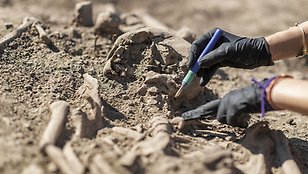Forensic anthropology

Photo: Getty Images
Analysis of skeletal remains are often crucial evidence, for example in cases of prolonged searches for missing individuals, cold cases and arson.
The Forensic Anthropology (FA) project examines methods for human identification (skeletal remains), specifically human interpretation processes using eye- tracking devices and AI (Levels 1 & 2). The aim of the project is to understand the decision making processes used in visual identification methods and its relationship to expertise. Gaze data from forensic anthropologists will be collected in experimental studies with a methodology derived from previous studies in eye tracking and FA. With the use of cutting edge technology such as eye-trackers specific gaze data can be collected for when participants perform specific tasks, enabling production of density maps with fixation points generated for each targeted skeletal area for sex and age. The gaze dataset will then be used to develop a potential AI model based on convolutional neural networks and deep neural networks for classification decisions.
The performance of the model will be evaluated as a complimentary decision tool for forensic anthropological sex and age-at-death decisions to look at the collaboration and integration of machine learning in forensic anthropology. The visual (eye-tracking) and AI approaches will enable understanding of FA decision-making strategies and also evaluation of the practicability, reliability, and accuracy of a deep learning model/tool as a methodological approach to classifications of sex and age. Furthermore, the evaluation of FA evidence by legal practitioners will be evaluated using legal case analysis (Level 3).
